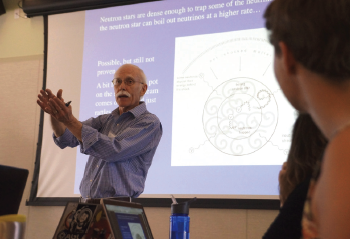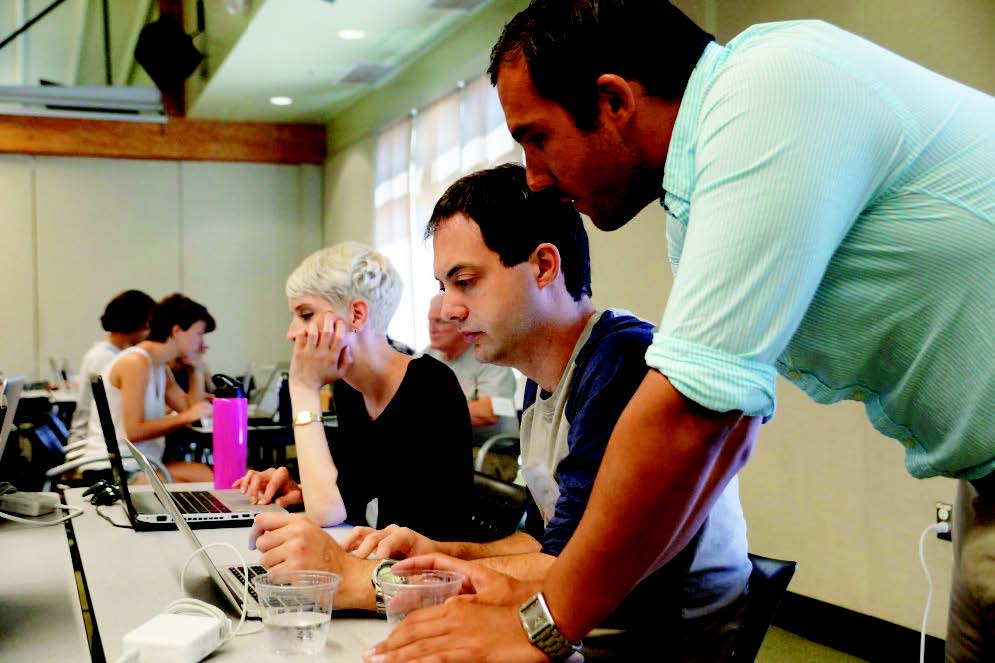 Craig Wheeler of the University of Texas, Austin, talks about massive stellar explosions. Photo by Sonia Fernandez
Craig Wheeler of the University of Texas, Austin, talks about massive stellar explosions. Photo by Sonia Fernandez
More than three dozen astrophysicists from across the United States and around the world gathered at UC Santa Barbara for MESA Summer School hosted by KITP. MESA, or Modules for Experiments in Stellar Astrophysics, is a software instrument for performing simulations of how stars change over time.
“MESA is the tool for anybody in science who is studying stars,” said KITP Director Lars Bildsten. “For more than half a century, we’ve understood at a reasonably detailed level how stars work. But it’s a complicated problem that involves bringing together many different pieces of microphysics, and the computational tools necessary to do that generally have not been open source. We’ve made the MESA code open source from its inception 10 years ago.”
Note the key phrase “open source,” which means that anyone can download the program and use it. However, as Bill Paxton, a senior fellow in computational astrophysics at KITP and MESA’s primary developer, said: “Learning to play MESA is like learning to play the piano. You’re going to have to end up putting in lots and lots of hours to really get good at it.”
Hence, MESA Summer School, where for the past four years undergraduate and graduate students, postdocs, professors and even avid amateurs have spent five days immersed in learning the nuts and bolts of using the program as well as how to tweak it to address their own research questions.
MESA began as a hobby for Paxton, who retired at a young age from Adobe Systems, where he worked on the development of PostScript and portable document format (PDF). He met Bildsten while auditing classes at UCSB and when Paxton exhausted the physics and math classes available, Bildsten suggested he conduct research. And the idea for MESA was born. It has evolved over the years, becoming more and more complex. This summer school intensive is one of the best ways for users to become proficient.
The specific topics covered at the summer school vary from year to year, depending on the lecturers. The 2015 lineup included Josiah Schwab, a graduate student at UC Berkeley who has been a MESA teaching assistant or lecturer for three summers. He opened the session with a technical introduction to MESA. “I really focused on how MESA works under the hood and how to change the program in order to study a particular problem,” Schwab said. “The fun thing about these gatherings is getting a feel for the myriad ways people use MESA.”
 KITP astronomer Iair Arcavi (center) and a fellow MESA Summer School participant confer.
KITP astronomer Iair Arcavi (center) and a fellow MESA Summer School participant confer.
Astrophysicists employ MESA to understand how stars oscillate and to study stars and binaries, two stars orbiting each other. “MESA can now simulate both stars simultaneously,” Bildsten explained, “even when one is dumping matter onto the other — a mass transfer. With MESA, you can actually simulate one losing mass and the other gaining mass.”
Some scientists use the program to model extrasolar planets — planets that orbit a star other than the sun — and others to explore supernovae, which are massive dying stars more than 10 times the mass of the sun. MESA can calculate the full range of fusion reactions that take place in supernovae.
“This year in particular there were a lot of improvements to how MESA evolves binaries,” said Monique Windju, a teaching assistant from UC Santa Cruz who made her second appearance at the summer school.
“I wanted to learn more about these new tools and get ideas about what I can do with my research topic. I also wanted to participate in astrophysics community development. Astrophysics globally is a very small community, so I’ll be seeing these people in the future without a doubt.”
Community building is key to MESA’s success, according to Frank Timmes, a professor in the School of Earth and Space Exploration at Arizona State University. He has been involved in MESA development for more than a decade.
“We definitely try to build a sense of community both at the summer school and online,” Timmes said. “The MESA Summer School is a seed for future collaboration. The participants become seeds at other places across the country and around the world for spreading the good news about this unique computational tool that is changing the way astrophysicists work.”
- Julie Cohen, UCSB Public Affairs & Communication
KITP Newsletter, Winter 2016
